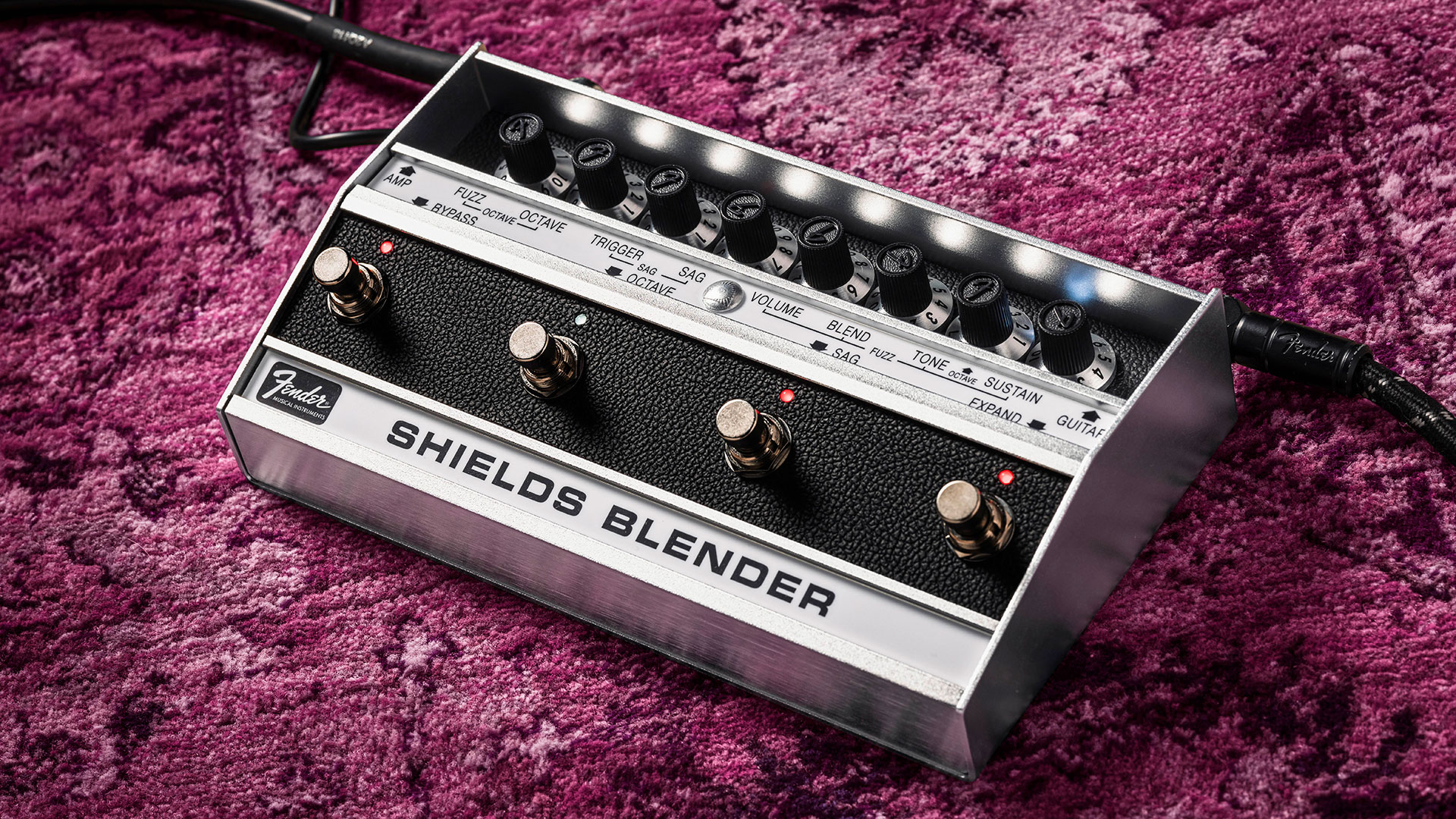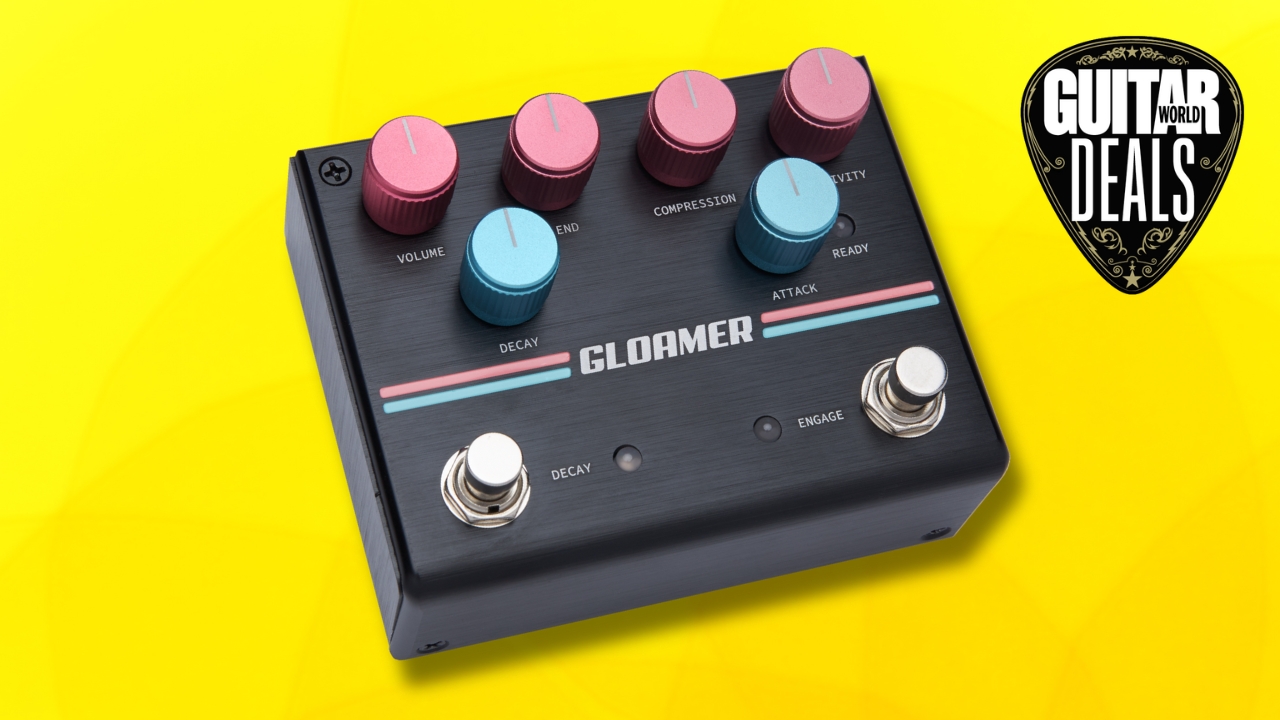"That otherworldliness comes from very tight rhythm playing": Kevin Shields on hiding music inside his new Fender pedal, his Jazzmaster setup secrets and what guitarists overlook about his technique
My Bloody Valentine's sonic architect on how he made a fuzz pedal that responds like an amp, that time he gigged without his rig, and why he has an entire pedalboard for one part in one song…

As a guitarist whose radical effect experimentations changed the sound of guitar playing forever, My Bloody Valentine's Kevin Shields is a man who knows a thing or two about fuzz pedals. It's no surprise, then, that his expanded reissue of the Fender Blender, the Shields Blender, sold out its limited run almost instantly.
Shields added two key features to the Blender: footswitchable sag and octave circuits. The octave circuit, in particular, makes sense thanks to Shields' prolific use of the Octavia.
Besides being an excellent fuzz pedal, building on the feature set of the original, it had a bonus inside: a memory stick containing a new Shields track. The presence of new music took what was already an anticipated gear release and made it headline music news.
Guitar World picked up the phone to discover why the Shields Blender isn't quite like any other fuzz, his pedal and guitar setup secrets, and get to the bottom of that hidden track...
When did you first get your hands on the Fender Blender?
"I'd been using the Roger Mayer Octavia, and I was on tour in America, and I came across this pedal, the Fender Blender, in a shop. I hadn't actually seen it before. I wasn't aware of it, but I saw it had the word 'fuzz' on it, so I thought 'all right' and just bought it. I plugged it in that day at soundcheck, and it was like the Octavia, but it had this whole other character. So it became my favorite pedal for the rest of that tour."
What was that other character? What did you like about it?
Get The Pick Newsletter
All the latest guitar news, interviews, lessons, reviews, deals and more, direct to your inbox!
"I was able to do something weird when I played, something unusual that I couldn't do with anything else. I think it's the way certain pedals break up. I don't mean break up in a distortion way, but I mean when you push past what's reasonable, and you're playing very hard.
"Sometimes you get the odd pedal that changes its character in a really different way to others... It was fuzzier, warmer, and for want of a better word, more touch-sensitive. It could have just been that I picked up a '60s pedal in the late '80s. The sound you get from those components could have well been part of the revelation, when you're used to hearing modern stuff."
What year was this?
"I think it was '89. The Isn't Anything tour, when we were playing around that time. I just remember that was the first time we got to America. It could have even been '88, to be honest with you, but it was that era, well before Loveless."

For the signature, you put a new song inside. How did that come about?
"Fender originally said to me, 'Could you make a 30-second pedal demo or something?' I'm not really capable of doing things like that – all I can do is make up tunes, and play music. That little tune, or whatever you want to call it, is just me using the pedal, but they were surprised it was an actual little tune as opposed to some sort of noise demo thing. I just made it up on the spot one evening.
"I find it very difficult to make music without a melodic basis, if there's no 'song', for want of a better word, or chord progression, or something interesting that keeps me going. Then the sound thing becomes really fun, as opposed to just making sound for the sake of sound. That's fun as well, but..."
What do you like most about the signature Blender?
The sag control puts in a similar touch sensitivity that you get from an amplifier interaction
"When you use it subtly, with the sag control, that's when it becomes something that's really expressive. If you play a certain way, it's more or less exactly like an amplifier, where you have that kind of classic, just-about-overdriven sound that you can back off and it's clean, and then play harder and it's quite overdriven. So the pedal has that quality.
"Normally, fuzz pedals aren't like that; they're just on. Then it's more or less [gain] – because of the nature of how fuzz works, it's turning things into a square wave. The sag control puts in a similar touch sensitivity that you get from an amplifier interaction. People that are very much into their playing as part of the way they express themselves, rather than just sound, it could actually be… Well, I'm curious to see if people pick up on it."
So the sag control is key to the signature?
"Plenty of pedals have a sag control, and I've often gotten them and tried them, and thought, 'That's kind of cool, but it's not doing that much.' Because I know what my amps do, and I know what I've achieved with amplifiers and speakers and stuff, and it's amazing the implosion effect, you know the Neil Young thing? Neil Young was the guy that pioneered that, with his Fender Deluxe. He really got into the subtleties of where you can make it explode, or implode. Something that you can control, and go way further."

Since we're talking signatures, Fender slide you a blank piece of paper. How do you spec a signature Jazzmaster?
"I'm not sure, to be honest, because I've gone in a few different directions. Like everyone who plays guitar, there's a whole bunch of things I like, which I think a lot of people like. Things like very resonant bodies. Light, but resonant. When you find that magic guitar that's so loud and resonant, and it's so acoustic in its resonance. That's one thing I really love about certain guitars.
"Then again, there are plenty of guitars that aren't very resonant that I've used a lot because they just sound good when they're plugged in. When I'm in shops and I'm picking up old Jazzmasters and Jaguars, I very much just play them un-plugged in, mostly. Unless something has gone horribly wrong with the pickups, if it sounds good when you're playing it acoustically, it's probably going to sound really good [when you plug it in].
"I like the necks that go thinner and thicker as they go up. Like a lot of those '60s guitars that are significantly thinner, and as you go up the neck, they go fatter – as opposed to being more uniform as they go up the neck. Some are more exaggerated. I always find I enjoy playing guitars like that more. Then, I wouldn't call it a rabbit hole, but the whole area of the tremolo arm and the bridge. I would like to experiment with that a little bit. It's the subtle things."
Like what? What would you change – aftermarket parts? A Mastery bridge?
"Mastery are good, and I've tried them. I do have some guitars with that stuff on. Basically, I've found a way of setting the guitar up. The reason they stay completely in tune when I'm recording, or live, for at least one song, anyway. Normally I can go for quite a while if it's set up – I can go for an hour and it won't go out of tune. Because I use the tremolo arm a lot, that puts a lot of stress on tuning. You can pick up a Jazzmaster if it's not set up correctly, and use the tremolo arm and it'll be immediately out of tune. But if it's set up well [that won't happen].
"The idea of a floating bridge is that it moves, so the pressure, the gliding the strings over the bridge, the bridge is moving more. It is all about tilting the bridge back, then obviously the intonation is all wrong, so then I have to reset all the intonation based on the bridge tilted back. That can be difficult sometimes with some guitars and some string gauges. I tilt it back so that rather than sitting horizontal to the guitar, it's leaning sideways, backwards, so that gives a longer throw, for want of a better word. The idea is that the strings don't glide over the bridge, but that they grab the bridge.
I really learned how to set up the Jazzmaster in the studio – that was the mad part. It was the desperation of trying to figure out how to really be in tune
"I first got that idea after trying all the things like putting lead pencil on it, everything. I've tried every type of tremolo, every expensive Floyd Rose and everything. We have a Jaguar that is damaged, and you can see it's the one that I experimented with all the different tremolo arms. In the end, I realized I wasn't going to technology myself out of this situation of tuning, it was going to be something else.
"Because I didn't like the feel of all those tremolo arms – I just couldn't find something. It's the feel of the Jaguar-style that allows me to play in a certain way. Because I don't actually hold it; it's just in the palm of my hand, where my wrist is. It's the fact it's so loose, unlike a Bigsby-style. I haven't found anything on any level that replaces it in any way, it just works perfectly."
So the only requirement is a Jazzmaster or Jaguar trem?
"All I know is, the way I set it up is really good, if you want to use the tremolo arm. I really learned how to do it in the studio – that was the mad part. It was the desperation of trying to figure out how to really be in tune."
What kind of gauge are you using here?
"I use a Jazzmaster-friendly gauge, which is I think 46-11. It likes that. 52-12, it would also really like. That weight, that heaviness, it's weird but the lighter gauge string, the lack of tension, makes that effect of the floating bridge less [effective]. I think that's why they've moved in design and they're using the Mustang bridges a lot now. And of course Mastery bridges, which solve millions of problems for people that want to be able to use it and not think about it. But I use it in a different way, that weirdly the floating bridge really works for."
Speaking of playing, what's an aspect of your playing that you think most people don't pick up on?
"One of the things that's less talked about but that would be very characteristic would be – let's use a song like Soon as an example. The reason why it sounds so fluid is because of very accurate rhythm guitar playing. The rhythm glides across, the bass and guitar are fast, basically, but played in a subtle way.
"For example, the bass doesn't have lots of compression on it. You don't hear it as fast, you hear it as fluid. It's the invisibleness of the rhythm that makes it appear very liquid. If it was more rock 'n' roll, or more – I don't know how to describe it – not super-locked-in, it would come across as more clanky, or human-sounding, for want of a better word. That otherworldliness comes from very tight rhythm."
What has changed about your pedal usage from the time you picked up your first Fender Blender to now?
In the middle section of You Made Me Realise, we really go for the whole shaking, rumbling thing. I've got one pedalboard just for that
"When we reformed, switching technology had gotten more sophisticated. So it became really easy for me to go, 'I want to use this pedal on this song', and not worry about it because of the routing system. Of course, that meant I had 50 pedals on stage, but at any given time I was using like, two. Maybe three or four, depending on the loop."
A lot of people would probably be surprised at how simple your signal path is at any given time.
"There's exceptions, like the song You Made Me Realise. The middle section in that, we really go for the whole shaking, rumbling thing. I've got one pedalboard just for that. It's got eight or 12 pedals on it, and I'm always messing with them and changing them. So for one part of one song, I've got a whole pedalboard. Back in the day, that would go on for 15 minutes, half an hour, whatever, more.
"I essentially had many variations on Octavia-type pedals. The Fender Blender, basically, was part of it [until] I stopped taking it on tour. It was the only one I had, and this was pre-Reverb days. I didn't see them around, ever."
What's the cheapest pedal you've bought that you actually use, that's say, on your touring board?
"I think there's a lot of those mini pedals with a very small footprint, they're just about big enough to fit a jack in the side. Those ones. I picked up some of them. Any of them that would do any kind of an Octavia effect. Fuzz or Octavia ones. I've been on a constant journey with trying to find something that I'm happy with for Only Shallow.
"I would say that would be my least successful live interaction. Live, I don't try and do the exact same thing [as the record] or anything, but at least to me it's as good, or more interesting. But for that one it's not as good. So for that one I've gone through 20 pedals, trying to find a certain kind of tremolo or even vibrato [that would work]...
"If you wanted to do it with tremolos, what you'd want to do is have two lines, two different tremolos, and then to get the effect of three different tracks of that, you'd need to get three different [sets], so that's six different tremolos going, and that takes care of one part of the sound. Then you'd have to do the backwards part, and the octave part. I've just about managed it, but the tremolo part is the part that I haven't succeeded in doing properly."
So, in the imaginary world where you're on tour and your gear goes missing, what's the minimum you could play a set with?
Nearly all pedals that have reverse reverb, there's too long a gap between your playing and [the effect] – you can't get it tight. It's not granular enough
"I've done that, I've done that [laughs]. I've been in exactly that situation. I bought three pedals, and I didn't even use them all – I think I just used two of them. One was a Red Panda [Context] pedal with a gated effect.
"Dinosaur Jr. were doing a residency in New York, celebrating an anniversary. They asked me to play, and they wanted to play Thorn, so I knew I needed some kind of reverse reverb. There was a guitar shop around the corner that had lots of pedals, some reverse reverb, but none of them close to what I needed. The Red Panda did the thing I needed, though I think it wasn't even called a reverse reverb. It had the timing, because it's the feel and timing that's crucial.
"I then got a distortion that had an oscillator effect on it, a Japanese pedal with a sun on it [probably a Lastgasp Art Laboratories fuzz – Ed]. I just had those couple of pedals and it was fine."
No surprises that you'd have strong opinions about reverse reverb...
"For a few minutes I was sweating it, because nearly all pedals that have reverse reverb, there's too long a gap between your playing and [the effect] – you can't get it tight. It's not granular enough.
"The [Yamaha] SPX-90 would be a perfect example. How it does its gated and reverse reverb effects is they're quite large blocks of sound, and when you hit it percussively, the amplitude is being manipulated to get the effect but there's no backwards-ness going on [and therefore no delay].
"So what was cool was when you play softly it happens a little bit, and when you play hard, it happens a lot. So you have this massive dynamic range available... it's hugely expressive. Most pedals that are made now are not as expressive – I don't know why."
What keeps you coming back to making music?
"I think people wind up being involved in music because it has a huge emotional effect. You have one reality, then you hear this music, then suddenly it's a different reality... I think people that aren't very affected by music don't really like music very much. It just sounds like noise. Annoying sound. The sound of egos going crazy. People that are affected by it emotionally hear the opposite; you hear something that's way bigger than any people, or any thing. That's the funny thing about music."
- For more information on the Shields Blender, head to Fender.com.
Alex Lynham is a gear obsessive who's been collecting and building modern and vintage equipment since he got his first Saturday job. Besides reviewing countless pedals for Total Guitar, he's written guides on how to build your first pedal, how to build a tube amp from a kit, and briefly went viral when he released a glitch delay pedal, the Atom Smasher.
“Seeing friends and heroes of mine having their solos plagiarized broke my heart”: Giacomo Turra used their solos note-for-note for his own viral content. Now the guitarists who had their playing “stolen” are speaking out
“Something’s stirring behind closed doors…” Joe Satriani plays For the Love of God? Steve Vai and Satch tackle each other’s most iconic leads in first SatchVai Band rehearsal footage











